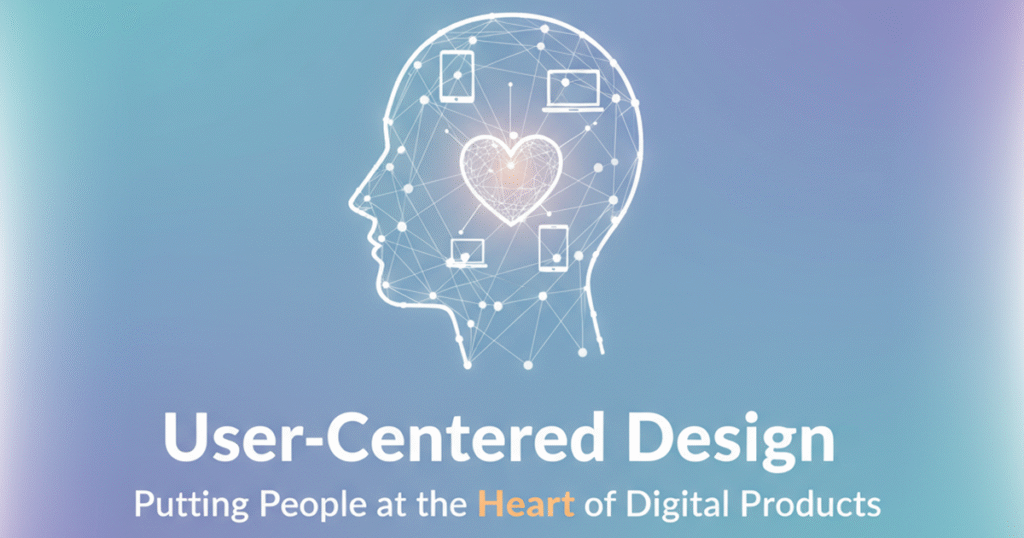In today’s fast-paced digital world, User-Centered Design (UCD) has become more than just a design principle—it’s a necessity. Products and services that fail to address real human needs are quickly abandoned. To thrive in 2025, organizations must adopt UCD as a mindset, not just a process. By embedding User Research and Feedback, following UX Design Best Practices, and committing to Human-Centered Product Design, companies can create experiences that resonate, delight, and endure.

User Research and Feedback
Strong user experiences begin with strong research. User Research and Feedback help uncover what users truly need, rather than what designers assume they want.
Qualitative & Quantitative Insights: Combining interviews, focus groups, and usability tests with analytics and surveys provides a balanced picture.
Co-Design With Users: Involving people in creating interview guides or prototypes leads to deeper, more authentic insights.
Early & Continuous Testing: Iterating from low-fidelity sketches to working prototypes helps catch usability issues before launch.
Feedback Loops: Embedding regular user feedback throughout the lifecycle ensures products remain relevant after release.
UX Design Best Practices
To transform research into meaningful design, teams should apply proven UX Design Best Practices:
1.Empathy First: Develop personas, journey maps, and context studies to align with real user goals.
2.Accessibility and Inclusivity: Make accessibility a baseline requirement, not an optional add-on.
3.Rapid Prototyping: Test ideas early to validate assumptions and reduce costly redesigns.
4.Ethical Design: Uphold fairness, transparency, and privacy, especially when integrating AI features.
5.Emotional and Functional Balance: Create products that are not only useful but also enjoyable.
Human-Centered Product Design
At the core of Human-Centered Product Design is the principle of designing for people in their real-world contexts. This means looking beyond usability to emotional, cultural, and ethical dimensions.
Accessibility & Diversity: Designing for users of all abilities, literacy levels, and cultural backgrounds ensures inclusivity.
Trust in AI Systems: With AI-driven tools on the rise, UCD helps ensure transparency, fairness, and explainability.
Business Benefits: Products built around users experience stronger retention, loyalty, and satisfaction while reducing costly post-launch fixes.
Trends to Watch in 2025
AI-Powered Personalization: Predictive insights must still align with human values.
Remote Research: Expands reach across diverse cultures and geographies.
Inclusive Design for Underrepresented Groups: Bringing marginalized voices into the design process.
Accessibility as Standard: A non-negotiable foundation of every digital product.
Common Pitfalls & How to Avoid Them
Sampling Bias: Avoid designing only for people like yourself.
Over-Reliance on Metrics: Balance data with human stories.
Skipping Testing: Rushing to launch without usability tests creates long-term issues.
Ethical Blind Spots: Failing to address privacy, bias, and transparency.
Bringing User-Centered Design Into Practice
1.Plan & Understand: Identify real users and their contexts.
2.Design & Prototype: Sketch, wireframe, and involve users early.
3.Test & Refine: Run usability tests, analyze feedback, and iterate.
4.Launch & Monitor: Measure adoption, collect real-world feedback, and make adjustments.
5.Scale & Embed UCD: Train teams, set KPIs, and make UCD part of company culture.
Conclusion
User-Centered Design is not just a methodology—it’s a commitment to putting people first. By grounding your process in User Research and Feedback, applying UX Design Best Practices, and embracing Human-Centered Product Design, your team can create solutions that are both practical and meaningful. The most successful digital products in 2025 will not be those with the flashiest features, but those that put real people at the center of design.
Frequently Asked Questions
1. What is User-Centered Design in digital product development?
User-Centered Design (UCD) is a process that focuses on building digital products based on real user needs, behaviour, and feedback. At Brigita, we use UCD to help enterprises across India, UAE, Dubai, GCC, and the USA create intuitive and high-performing experiences.
2. How does Brigita use AI to improve User-Centered Design?
Brigita uses AI for behaviour analysis, rapid usability testing, and insight generation. This helps teams quickly identify friction points, improve UX quality, and scale digital products for global markets.
3. How does UCD improve website SEO and engagement?
A strong UCD approach lowers bounce rate, increases session time, and enhances user satisfaction—factors that directly support SEO. Brigita aligns UCD with SEO and AEO best practices to boost search visibility across India, UAE, and the USA.
4. Why is accessibility important in User-Centered Design?
Accessibility ensures your digital product is usable for people of all abilities. Brigita follows global accessibility standards to deliver inclusive experiences that broaden audience reach across diverse regions including GCC, UAE, and India.
5. Why should businesses choose Brigita for UCD and UX design services?
Brigita combines AI-driven insights, design thinking, product engineering expertise, and global delivery experience to build user-focused digital products. We help enterprises create scalable, intuitive, and performance-ready experiences for worldwide audiences.
Search
Categories

Author
-
Mariappan P is a Senior Front-End Developer with 4+ years of experience, specializing in Angular (3 years) and React (1+ year). He is passionate about building scalable, user-friendly web applications and leveraging modern technologies to deliver innovative solutions. Mariappan thrives on solving complex problems, optimizing performance, and creating seamless user experiences. Outside of work, he enjoys exploring emerging tech trends, contributing to side projects, and staying active through outdoor activities and fitness.
